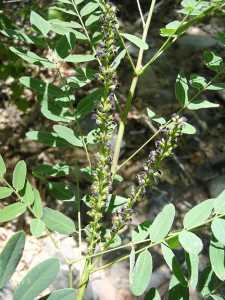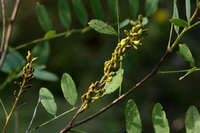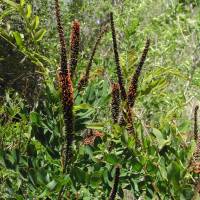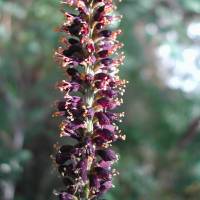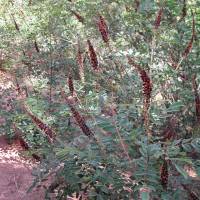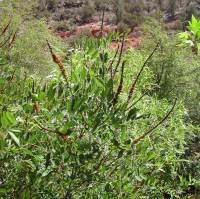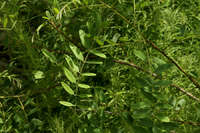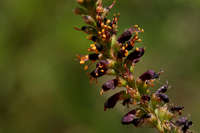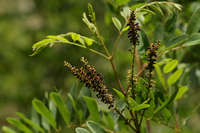As represented by my specimens this species is restricted to the alluvial bottoms and banks of the Lower Wabash Valley and the moist or rocky slopes of the Ohio River. I have one specimen, however, which is from sandy soil near the Kankakee River south of Thayer, Lake County. Amorpha fruticosa and its varieties are locally common in the southwestern part of Posey County and in the southwestern part of Vigo County on the banks of sloughs and swamps where it is usually closely associated with buttonbush. I have this variety [var. angustifolia] from Spencer, Switzerland, and Vigo Counties and Miss McKee found it in Newton County near the Kankakee River. My only specimens of this variety [var. emarginata] are from the borders of sloughs in Gibson County.
Indiana Coefficient of Conservatism: C = 3
Wetland Indicator Status: FACW
Common Name: false indigo bush
Duration: Perennial
Nativity: Native
Lifeform: Shrub
Wetland Status: FACW
General: Shrub, reaches up to 4 m tall, often found along watercourses, short-pubescent herbage, the hairs appressed; bark grayish in color.
Leaves: Alternate along stem, pinnately compound, 7-20 cm long, with 11-21 leaflets oblong to obovate, glabrate, each 1.5-5 cm long, dark green above, lighter green below with slight pubescence along the veins.
Flowers: Racemose, fairly dense in nearly spikelike inflorescence up to 20 cm long, 1.5-5 cm wide, bearing many flowers; sepals canescent to almost glabrous, 3-4 mm long, upper two larger and broader at rounded apices, other sepals acute; petals dark blue to purple, to 5 mm long.
Fruits: Pods slightly exceeding the calyx, 5-7 mm long, gland-dotted, glabrous.
Ecology: Canyons and along streambanks from 2,000-6,000 ft (610-1829 m); flowers May-July.
Notes: When flowering, this is an easily identifiable plant, otherwise pay attention to the leaves and its habitat.
Ethnobotany: Stems used for bedding material, for arrows, and as a way to cover the ground to keep meat clean while butchering.
Etymology: Amorpha comes from the Greek word amorphos for deformed, while fruticosa comes from Latin frutex, meaning shrubby or bushy.
Synonyms: Many, see Tropicos
Editor: SBuckley, 2010
Branching shrub to 4 m; foliage not blackening in drying; petioles 2-5 cm; lfls 4-10+ pairs, green but not shining, 2-4 cm, usually sparsely short-hairy beneath; petiolules almost always pubescent; racemes (1)2-several, 6-20 cm; cal-tube 2-3 mm, the upper 4 lobes 0.5 mm, broadly triangular to half-orbicular, the lowest one somewhat longer and narrower; banner 5-6 mm; fr 5-9 נ2-4.5 mm, strongly glandular, the upper margin usually strongly bulged upward; 2n=40. Moist woods and stream-banks; N.H. to Minn. and s. Sask., s. to Fla., Tex., s. Calif., and n. Mex. May, June. Variable, but not clearly divisible. (A. croceolanata, a southern phase with loose, often tawny or orange pubescence)
Gleason, Henry A. & Cronquist, Arthur J. 1991. Manual of vascular plants of northeastern United States and adjacent Canada. lxxv + 910 pp.
©The New York Botanical Garden. All rights reserved. Used by permission.





